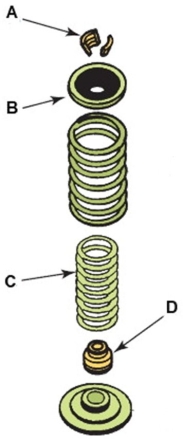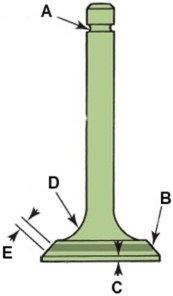A) 1-3 degree
B) 0.5-0.75 degree
C) 0.005 degree
D) 1 degree
F) B) and D)
Correct Answer

verified
Correct Answer
verified
Multiple Choice
Which of these components is the valve seal? 
A) A
B) B
C) C
D) D
F) All of the above
Correct Answer

verified
Correct Answer
verified
Multiple Choice
Technician A says that the exhaust valve is larger than the intake valve to ensure that all the exhaust gases leave the cylinder. Technician B says that the exhaust valve is larger than the intake valve to ensure proper heat dissipation. Who is right?
A) Technician A only
B) Technician B only
C) Both technicians A and B
D) Neither technician A nor B
F) A) and B)
Correct Answer

verified
Correct Answer
verified
Multiple Choice
Installed height is the distance between the valve spring ________ and the underside of the valve spring retainer.
A) Seat
B) Edges
C) Keepers
D) Coils
F) All of the above
Correct Answer

verified
Correct Answer
verified
Multiple Choice
Technician A says that all valves rotate to help prevent the valves and seats from burning. Technician B says that positive type valve rotators are only used on intake valves. Who is right?
A) Technician A only
B) Technician B only
C) Both technicians A and B
D) Neither technician A nor B
F) B) and C)
Correct Answer

verified
D
Correct Answer
verified
Multiple Choice
In a normally operating engine, intake and exhaust valves are opened by a cam and closed by ________.
A) Rocker arms or cam follower
B) Lifters/tappets
C) Valve springs
D) Valve guides and/or pushrods
F) None of the above
Correct Answer

verified
Correct Answer
verified
Multiple Choice
To lower and narrow a valve seat that has been cut at a 45-degree angle, use a cutter or stone of what angle?
A) 60 degrees
B) 30 degrees
C) 15 degrees
D) 45 degrees
F) A) and D)
Correct Answer

verified
Correct Answer
verified
Multiple Choice
Never remove more material from the tip of a valve than ________ inches.
A) 3070.050
B) 0.020
C) 0.001
D) 0.002
F) None of the above
Correct Answer

verified
Correct Answer
verified
Multiple Choice
Which part of this valve is called the valve margin? 
A) A
B) B
C) C
D) D
E) E
G) A) and B)
Correct Answer

verified
Correct Answer
verified
Multiple Choice
A valve seat should be concentric to the valve guide to a maximum TIR (total indicator runout) of ________.
A) 0.004 in.
B) 0.002 in.
C) 0.006 in.
D) 0.0015 in
F) A) and D)
Correct Answer

verified
Correct Answer
verified
Multiple Choice
Technician A says that a pilot is placed into the valve guide to position the stone or cutter correctly for resurfacing the valve seat. Technician B says that he installed height should be checked and corrected with oversized valves, if needed. Who is right?
A) Technician A only
B) Technician B only
C) Both technicians A and B
D) Neither technician A nor B
F) A) and B)
Correct Answer

verified
Correct Answer
verified
Multiple Choice
Umbrella-type valve stem seals ________.
A) Fit tightly onto the valve stem
B) Lock under the valve retainer
C) Fit tightly onto the valve guide
D) Fit on the valve face to prevent combustion leaks
F) None of the above
Correct Answer

verified
Correct Answer
verified
Multiple Choice
Technician A that says free and positive are two types of valve rotators. Technician B says that valve grinding should start with truing the valve tip; then the face should be refinished. Who is right?
A) Technician A only
B) Technician B only
C) Both technicians A and B
D) Neither technician A nor B
F) None of the above
Correct Answer

verified
Correct Answer
verified
Multiple Choice
Technician A says that valve stem height should be checked and the top of the valve ground, if necessary. Technician B says that after a thorough cleaning, the cylinder head should be assembled using new valve stem seals. Who is right?
A) Technician A only
B) Technician B only
C) Both technicians A and B
D) Neither technician A nor B
F) B) and D)
Correct Answer

verified
Correct Answer
verified
Multiple Choice
Technician A says that valve springs should be kept with the valve at the time of disassembly and tested for squareness and proper spring force. Technician B says that the exhaust valve is about 50 percent of the size of the intake valve. Who is right?
A) Technician A only
B) Technician B only
C) Both technicians A and B
D) Neither technician A nor B
F) C) and D)
Correct Answer

verified
A
Correct Answer
verified
Multiple Choice
Valve spring inserts (shims) are designed to ________.
A) Decrease installed height of the valve
B) Decrease valve spring pressure to compensate for decreased installed height
C) Adjust the correct valve spring installed height
D) Increase installed height of the valve
F) All of the above
Correct Answer

verified
Correct Answer
verified
Multiple Choice
The proper relationship between intake and exhaust valve diameter is ________.
A) Exhaust valve size is 85% of intake valve size
B) Intake valve size is 85% of exhaust valve size
C) Intake valve size is 45% of exhaust valve size
D) Exhaust valve size is 38% of intake valve size
F) C) and D)
Correct Answer

verified
Correct Answer
verified
Multiple Choice
Which of these is the most common valve spring keeper?
A) Horseshoe
B) Clip
C) Conical
D) Split keepers
F) A) and C)
Correct Answer

verified
D
Correct Answer
verified
Multiple Choice
Dampers (damper springs) are used inside some valve springs to ________.
A) Keep the valve spring attached to the valve
B) Decrease valve spring pressure
C) Retain valve stem seals
D) Prevent valve spring surge
F) None of the above
Correct Answer

verified
Correct Answer
verified
Multiple Choice
The type of valve in use today is a ________ valve.
A) Elliptical
B) Aluminum
C) Poppet
D) Rhodium
F) B) and C)
Correct Answer

verified
Correct Answer
verified
Showing 1 - 20 of 22
Related Exams